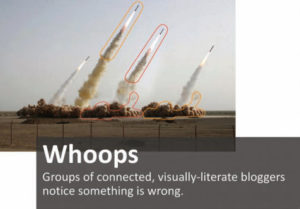
Is the Internet changing how people think? One school of thought says yes, the Internet is rewiring our brains and not for the better. Nicholas Carr has written, “I’m not thinking the way I used to think… [W]hat the Net seems to be doing is chipping away my capacity for concentration and contemplation.”1
Clive Thompson agrees with many of these fears, but he is intent on celebrating the upside of the Internet age. In his witty and insightful talk, based in part on his 2013 book, Smarter than You Think: How Technology Is Changing Our Minds for the Better, Thompson explained four ways the Internet is changing the way we think and share ideas, giving us a better understanding of our world.
The first is what Thompson calls “public thinking.” Where we once did most of our thinking by ourselves or with a few friends and family members, the Internet has allowed us to broadcast our thoughts instantly to huge audiences through emails, texts, blogs, comments, and social media posts. The average person is writing more today than perhaps at any time in history, contributing as many as 3.6 trillion words a day, equivalent to the entire contents of the Library of Congress.
Is this torrent of words a good thing? Not necessarily, Thompson says, but it has had an effect on human thought. We now have the ability to know what thousands of people are thinking right now and understand that many of them are having the same ideas that we are having. Many of these ideas are novel and interesting, because when we write publicly, in front of other people online, we experience the “audience effect.” We feel the need to be a slightly more interesting and articulate version of ourselves.
The second change is what Thompson calls a new “ambient awareness” of other people. The advent of messaging through texts and Twitter is changing the way we know each other. When texting and Twitter first appeared, many people were skeptical. Thompson remembers thinking, “Is this (a 140-character message) what civilization has come to?” But anthropologists are learning that some people—Japanese teenage couples, for example—are able to gain a unique ambient awareness of each other through thousands of short, frequent messages, a kind of ESP into the other person that is not possible through less frequent, higher-bandwidth communications, such as telephone calls.

Third, the Internet has created several new forms of literacy. One is what Thompson calls “photographic literacy.” Decades ago, newspaper readers believed that news photographs portrayed their subjects literally. Although other examples surely exist, Thompson pointed out that Joseph Stalin pioneered the art of manipulating photographic images, erasing offending commissars from official photographs in an attempt to revise history. In the 1980s, with the advent of Photoshop, people began to understand how easily photos can be manipulated. Photo manipulators now had a harder time tricking people. In 2008, Iran published a propaganda photo (see Figure) showing the simultaneous launch of four missiles. Newspapers around the world ran it on the front page. But, as Thompson relates, online bloggers “smelled a rat” and pointed out that the plume from missile number 4 was identical to the plume from missile number 3. The Iranians had copied and pasted in a fourth missile to make the launch look more impressive. Newspaper editors had missed this but the photographic literati had not.
Fourth, the Internet has advanced human collaborative thought. The Internet has connected billions of minds, and this has opened up new ways of solving problems. Need to learn how to use high-speed power tools? YouTube has tens of thousands of videos from people who are skilled at that. Need to figure out how to fold a cellular protein structure into the smallest space? To do that decades ago, biochemists would have needed a supercomputer that was only available to large institutions. Thompson related how the Internet has changed that. In 2010, researchers tossed such a problem to the Internet. Thousands of people began working on the folding problem simultaneously and solved it in a shockingly short time through collaborative thought, by testing ideas and rapidly telling each other what was working and what was not.
Note: The conclusions in this report are those of the author and do not necessarily represent the official position of the Centers for Disease Control and Prevention.
Reference
- Carr N. Is Google making us stupid?: what the Internet is doing to our brains. The Atlantic, 2008;July/August. www.theatlantic.com/magazine/archive/2008/07/is-google-making-us-stupid/306868/ (accessed 8 June 2015).
